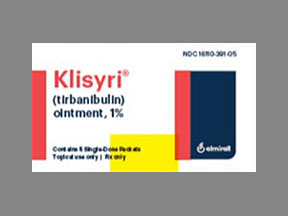
Klisyri (250 Mg) Coupons & Savings Card – Discount Prices from $174.90
My prescription
Edit
1%, Klisyri (250 Mg) (5 Ointments)
Select pharmacy

CVS
$224.42
COUPON PRICE
Albertsons
$174.90
COUPON PRICE
Walmart
$174.90
COUPON PRICE
Walgreens
$224.48
COUPON PRICEKlisyri (250 Mg) savings card
Show this card to your pharmacist
CVS
Couldn't load coupons
We were unable to get coupon information
Powered by
Price history for Klisyri (250 Mg)
5 Ointments, 1%
Average retail price for Klisyri (250 Mg)
Average SaveHealth price for Klisyri (250 Mg)
Our price history data is based on aggregated prescription data collected from participating pharmacies in America. Our prescription data updates daily to reflect the latest price changes. If you notice a missing data point, it means there wasn't sufficient data available to generate a monetary value for that date.
*Retail prices are based on pharmacy claims data, and may not be accurate when we don't have enough claims.
Klisyri (250 Mg) dosage forms
Dosage Quantity Price from Per unit 1% 5 Ointments $1101.84 $220.37 1% 1 Ointment $220.37 $220.37
| Dosage | Quantity | Price from | Per unit |
|---|---|---|---|
| 1% | 5 Ointments | $1101.84 | $220.37 |
| 1% | 1 Ointment | $220.37 | $220.37 |
Klisyri (250 Mg) Warnings
When using Klisyri (tirbanibulin) ointment for the treatment of actinic keratosis on the face or scalp, it's important to be aware of certain safety considerations to ensure proper use and minimize potential risks.
Eye Irritation: Klisyri may cause eye irritation if it comes into contact with the eyes or the area around them. To prevent this, avoid applying the ointment near the eyes and wash your hands immediately after application. If accidental exposure occurs, rinse the eyes thoroughly with water and seek medical attention promptly.
Local Skin Reactions: Application of Klisyri can lead to local skin reactions in the treated area, such as redness, flaking, scaling, crusting, swelling, blistering, or ulceration. These reactions are typically mild to moderate and tend to resolve within a few weeks after completing treatment. However, severe reactions can occur. To reduce the risk of irritation, do not use occlusive dressings over the treated area and ensure the skin has healed from any previous treatments or procedures before applying Klisyri.
Use on Intact Skin: Klisyri should only be applied to intact skin. Avoid using the ointment on open wounds, broken skin, or areas where the skin barrier is compromised, as this can increase the likelihood of adverse reactions.
Sun Exposure: While undergoing treatment with Klisyri, it's advisable to minimize exposure to sunlight, including sunlamps and tanning beds. Excessive sun exposure can exacerbate skin reactions and may affect the treatment outcome.
Use in Specific Populations: The safety and effectiveness of Klisyri in individuals under 18 years of age have not been established. Additionally, there is limited data on the use of Klisyri during pregnancy or breastfeeding. If you are pregnant, planning to become pregnant, or breastfeeding, discuss the potential risks and benefits of using Klisyri with your healthcare provider.
By adhering to these precautions and following your healthcare provider's instructions, you can use Klisyri safely and effectively for the treatment of actinic keratosis.
Klisyri (250 Mg) Side Effects
Klisyri (tirbanibulin) is a topical ointment prescribed for the treatment of actinic keratosis on the face or scalp. While effective, its use may lead to certain side effects, primarily localized to the area of application. Common side effects include redness, flaking or scaling, crusting, swelling, and the formation of sores or ulcers at the treatment site. These reactions are typically mild to moderate and often resolve within two to three weeks after completing the treatment course. Additionally, some individuals may experience itching or pain, such as tenderness, stinging, or burning sensations, in the treated area. In rare instances, more severe skin reactions can occur, including blisters, pus formation, ulcers, or skin breakdown. If you notice any of these symptoms, it's important to contact your healthcare provider promptly. Furthermore, although uncommon, allergic reactions to Klisyri may happen. Seek immediate medical attention if you experience symptoms like rash, swelling (especially of the face, tongue, or throat), severe dizziness, or difficulty breathing. To minimize the risk of side effects, apply Klisyri exactly as directed by your healthcare provider. Avoid using it on open wounds or broken skin, and do not cover the treated area with bandages or dressings unless instructed. After application, wash your hands thoroughly to prevent accidental transfer to other areas, especially the eyes, mouth, or lips. If accidental contact occurs, rinse the area with water and seek medical care if necessary. If you have concerns about side effects or how to use Klisyri properly, consult your healthcare provider for personalized advice.
Klisyri (250 Mg) Interactions
What is Klisyri used for?
Klisyri is used for the topical treatment of actinic keratosis on the face or scalp. Actinic keratosis is a rough, scaly patch on the skin caused by years of sun exposure.
Is Klisyri a chemotherapy drug?
Klisyri is not a chemotherapy drug. It is a topical medication used to treat actinic keratosis on the face or scalp.
Is Klisyri FDA approved?
Yes, Klisyri (tirbanibulin) is FDA approved. It was approved in December 2020 for the topical treatment of actinic keratosis on the face or scalp.
Is Klisyri a chemo cream?
Klisyri is not classified as a chemotherapy cream. It is a topical medication used for the treatment of actinic keratosis on the face or scalp. It contains the active ingredient tirbanibulin, which works by inhibiting cell proliferation.
Why is Klisyri so expensive?
The cost of Klisyri can be attributed to several factors. These include the research and development expenses involved in bringing a new medication to market, the costs associated with clinical trials, and the regulatory approval process. Additionally, the pricing may reflect the drug's effectiveness, the cost of manufacturing, and the investment in ongoing research. Market exclusivity and the lack of generic alternatives can also contribute to its high price.
